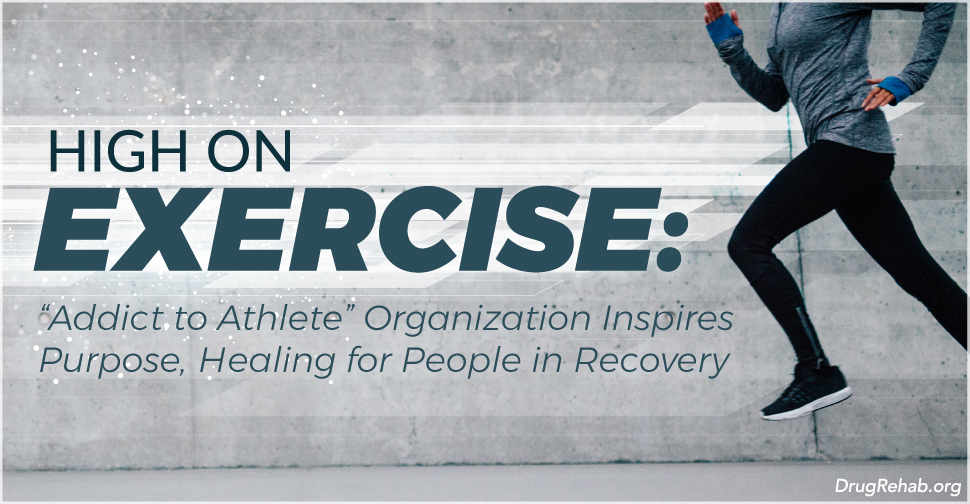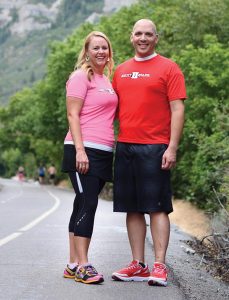
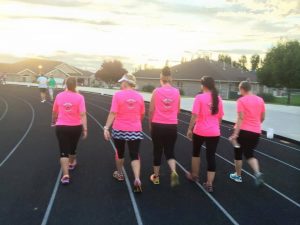
Top Left: Marissa and Blu Robinson, co-founders of “Addict II Athlete.” The non-profit helps people in recovery replace harmful habits with running and other forms of exericse. Top Right: Members of the sisterhood of Addict II Athlete take strides together. Bottom: Inmates in the substance abuse treatment program at Utah State Prison participate in a 5k Race sponsored by Addict II Athlete (Source: Utah Dept. of Corrections).
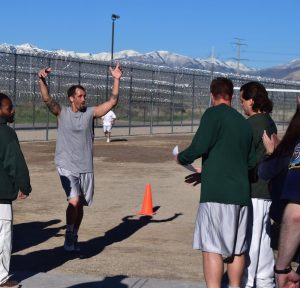
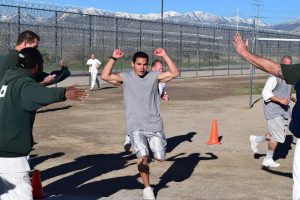
There are no war stories about hitting rock bottom at this Utah fellowship for people in recovery. Group members lean on each other, united by their desire to heal from drug and alcohol addiction. But they don’t fit a 12-step mold.
When they talk stigma, it’s about changing public attitudes. When they mention surrender, it’s often about wanting to give up in the final stretch of a grueling marathon – then finding the will to finish. They cheer each other’s fitness milestones. They recite a “Champion’s Creed” and help the newbies go from the couch to their first 5k.
“Addict II Athlete,” as the group is known, advances sobriety through physical fitness. The non-profit organization has about 800 members throughout Utah who bring awareness to the recovery movement and raise money for local charities with races and other events. The Utah State Prison has also adopted Addict II Athlete, incorporating the platform into its Con-Quest substance abuse treatment program for inmates.
“All I knew in my heart is that I needed change and that getting into shape seemed to be a great place to start,” says Tim Sedgley of Springville, Utah, who joined Addict II Athlete about a year after his release from prison.
Battling drug addiction and depression, Sedgley figured his sedentary lifestyle wasn’t helping.
“I remember thinking, ‘I just want to be able to run a mile without stopping’” he recalls.
Sedgley met that goal, then kept going. “I have completed two 50-mile ultra-marathons, a trail marathon, and many 5k, 10ks, and half marathons,” says Sedgley, a former high school dropout who earned his GED in recovery and is now working toward a bachelor’s degree in psychology. He has remained sober since joining Addict II Athlete in 2012.
Most men and women don’t consider themselves to be athletic when they join the group, says Blu Robinson, a Utah County mental health and substance abuse counselor who founded Addict II Athlete with his wife Marissa in 2011.
“There are no expectations that you have to be bigger, better, faster or stronger,” Robinson says. “I have seen faster athletes sacrifice their own race to walk alongside a newcomer. It’s what unifies and strengthens the team. It’s a metaphor to recovery, as no one ever finishes alone.”
Moving Past the Pain of Addiction
Each week, members of Addict II Athlete attend free support group meetings, followed by about 30 minutes of team recreation such as running, CrossFit, yoga or walking.
Volunteer coaches remind participants that the trials of running a half marathon are nothing compared to the agony of detox, prison life, or having their children taken away because of the addiction.
“No pain while working out will ever compare to that,” Robinson says. “So really, they are the experts of overcoming adversity. We talk about their life having the ability to inspire others –
to persevere and gain understanding that we have and can do hard things in life . . . and slowly, we move them from addict to athlete.”
 Transformation occurs alongside family members and loved ones, who are welcomed into the fellowship – where they are known as “Muggles.” Children of parents in recovery join the “Minor League” program. “We assist them in sporting events, swimming lessons, service-oriented activities, and even sponsoring them in their own pursuits,” Robinson says, adding that donations cover athletic shoes and race entry fees for participating youth.
Transformation occurs alongside family members and loved ones, who are welcomed into the fellowship – where they are known as “Muggles.” Children of parents in recovery join the “Minor League” program. “We assist them in sporting events, swimming lessons, service-oriented activities, and even sponsoring them in their own pursuits,” Robinson says, adding that donations cover athletic shoes and race entry fees for participating youth.
Service to the community is an integral part of Addict II Athlete. The team registers for one non-profit race each month, and raises funds for items such as adaptive wheelchairs to help disabled children cross the finish line, too.
Giving back is especially poignant when the cause relates to addiction-sensitive issues such as drunk driving or adoption. “When our team participates in these kind of activities, we always call ahead to ensure that the organizer knows who we are and why we want to participate,” Robinson notes. “It’s quite emotional to say the least.”
Finding Purpose in Prison
Nearly 90 percent of inmates in the Utah prison system have a substance use disorder or history of drug and alcohol problems, says Deputy Warden Greg Hendrix. He estimates that up to 300 offenders, male and female, have participated in Addict II Athlete.
“Every spring, we have a tradition of running a 5k. This has been an exciting part of Addict II Athlete in the prison setting,” Hendrix says. Inmates with running experience mentor the less experienced athletes, helping them rally toward a goal.
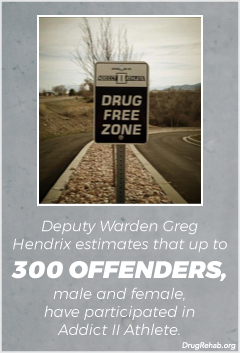 “Many of the runners that finish first will keep running to support those that are much slower,” he says. “(They) will return to the track on the final lap to help bring in the last runners. It has been great to see that kind of support.”
“Many of the runners that finish first will keep running to support those that are much slower,” he says. “(They) will return to the track on the final lap to help bring in the last runners. It has been great to see that kind of support.”
What endures from the Addict II Athlete experience, Hendrix says, is the team mantra that inmates embrace: “Erase and Replace.”
“This means they are erasing substance-using behaviors with new coping skills or rediscovering coping they used in the past,” he says. “They are finding that passion that kept them healthy before – or they are discovering, for the first time, a different passion.”
As they transition to life outside prison, inmates can use Facebook to find the nearest Addict II Athlete chapter. Sharing the joys of exercise with a sober support group “will increase their likelihood of staying sober and finding a lifestyle they want to live,” Hendrix notes.
Champions of Sobriety
Robinson knows firsthand how fitness can build connections and renew a broken spirit. Growing up, he endured physical abuse by multiple stepfathers, and lived with poverty and instability – moving 23 times in his youth. To escape his toxic childhood, Robinson began using drugs at 15 – following a path to addiction that was also taken by several of his siblings.
He committed to recovery in his 20s, and met his wife Marissa, a therapeutic recreation specialist, when both were working at a center for troubled youth.
“In my own life, my own sobriety, I knew that one major outlet I used was recreation –
mountain biking and specifically running,” Robinson says. “I knew that exercise increased self-esteem and decreased depression.”
So Robinson had the idea to create a pilot project, training some of his therapy clients to run their first 5k. As they gathered for warm-up stretches, the five volunteers were often anxious about their days ahead: meetings with judges and probation officers, temptations to use drugs.
“We’d begin processing these stressors before we would run, and on our return I would always ask how they felt,” Robinson says. “And every time, they experienced and expressed feeling better.”
One team member gave the inaugural group a shirt that read ‘Addict II Athlete’ – shedding the anonymity of their disease. “These individuals put their shirts on and ran their hearts out,” Robinson recalls. “Each one of them finished, each had family members who cheered for them, and couldn’t believe what they were doing.”
Today, Addict II Athlete has chapters in six Utah counties (two are pending) and Robinson hopes to expand to more states in the future. He sees Addict II Athlete as a meaningful complement to other recovery strategies and support, such as 12-step programs.
“We counsel our athletes to participate in the 12-step programs to gain a better understanding of the spiritual component of sobriety,” he says. “They use the team for support and recreation, and then do their own work with therapists and treatment programs to have a triad of sobriety and recovery.”
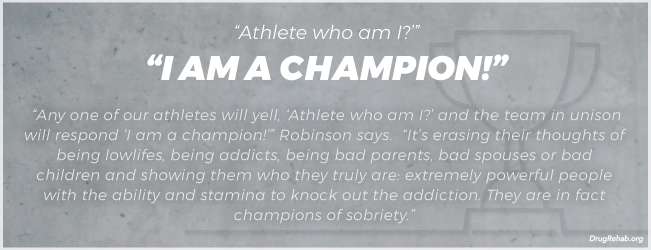
When they are feeling vulnerable, members of Addict II Athlete can invoke the Champion’s Creed. “Any one of our athletes will yell, ‘Athlete who am I?’ and the team in unison will respond ‘I am a champion!’” Robinson says. “It’s erasing their thoughts of being lowlifes, being addicts, being bad parents, bad spouses or bad children and showing them who they truly are: extremely powerful people with the ability and stamina to knock out the addiction. They are in fact champions of sobriety.”
Sedgley, who joined Addict II Athlete after prison and became an ultra-marathoner, says the experience goes beyond physical fitness.
“The real changes started when I found others accepting me onto the team,” Sedgley recalls. “They asked me how I was doing. I was invited on runs with the team, and also asked to help with service projects.”
“This team has given me confidence in myself, trust in others, and has helped me put my life into perspective,” Sedgley adds. “When I look back on my journey, I see that the game changing play was when I joined the team.”
For More Information:
Visit Addict To Athlete at: http://addicttoathlete.org or on Facebook at https://www.facebook.com/AddictToAthlete/
* * * * *

